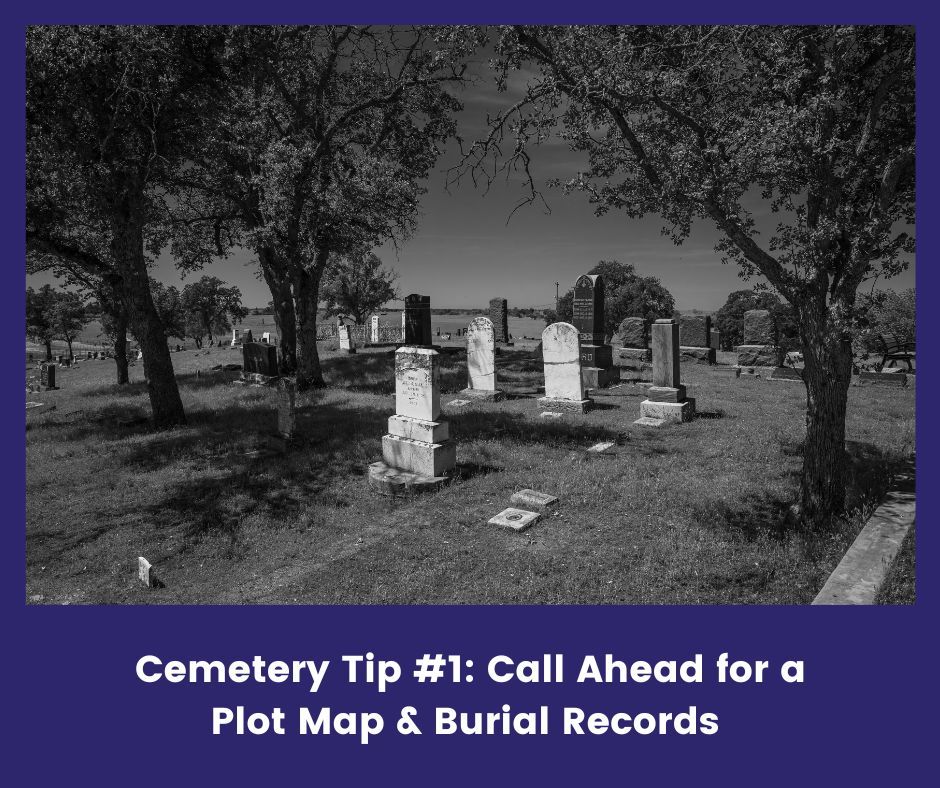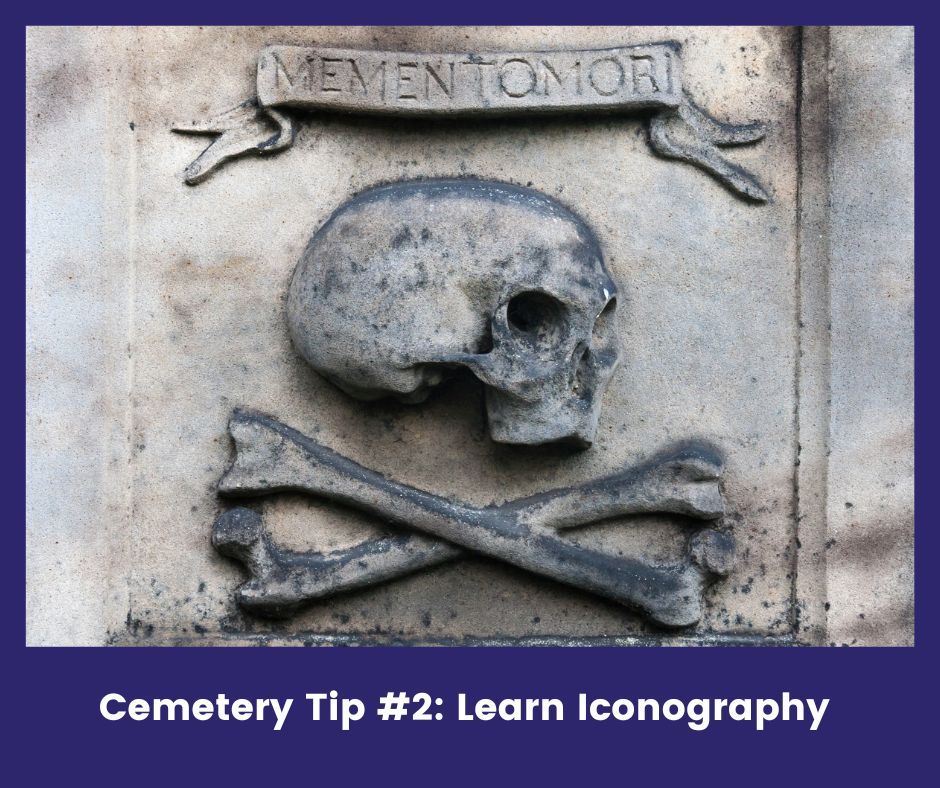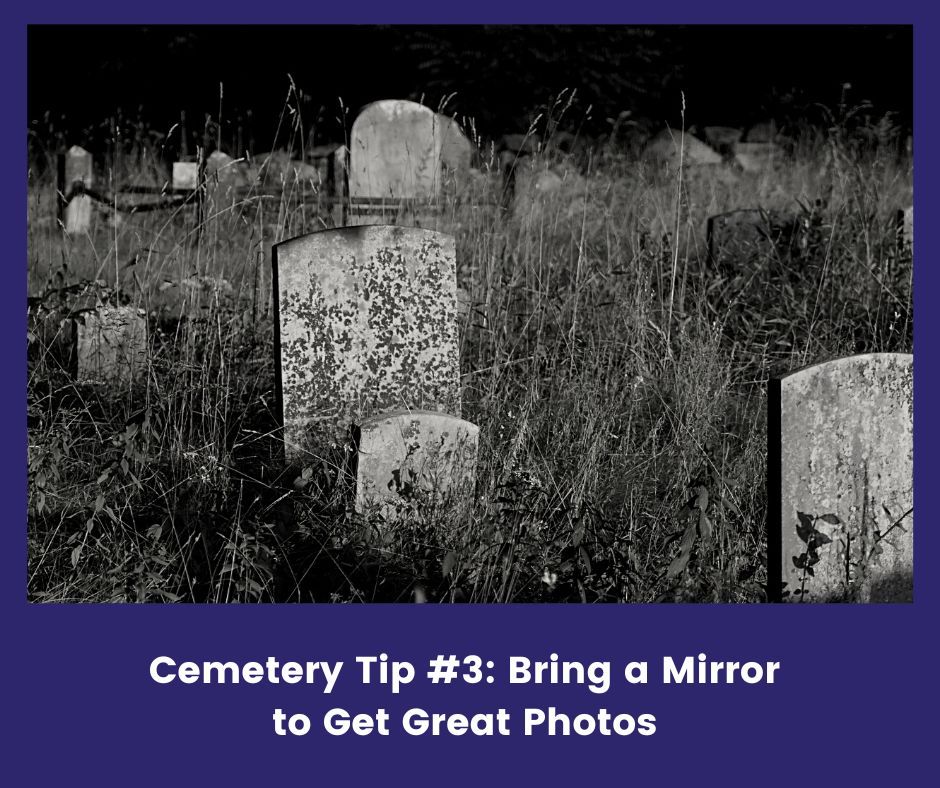What to Bring on a Cemetery Research Trip
Planning Cemetery Trips for Genealogy Research: Discover how to plan a cemetery research trip for genealogy research and learn how to make the most of your time there. Get tips on what to bring and how to prepare for your visit for family history research.

Planning on a trip to visit your ancestors’ graves?
Many genealogists research in cemeteries to find gravestones. The inscriptions on headstones along with their positions near other headstones can provide invaluable information for genealogy research.
This post covers how to prepare and what to bring to make the most of your time there.
Preparing to Research at a Cemetery
Once you know the location of your ancestors’ graves, a trip to the cemetery can unlock new knowledge about them. For an overview of how to do this, check out Podcast Episode 33: Analyzing Gravestones with Berks County Association for Graveyard Preservation.
Before you set foot in any cemetery, do some reading of the cemetery’s history. Check the two big websites FindAGrave.com and BillionGraves.com, then do an internet search on the name of the cemetery itself. Because cemeteries often share similar names, be sure to include the location. Example search term: "St. Mary's Cemetery Manayunk PA History" returns this page with this information:
ST. MARY OF THE ASSUMPTION CHURCHYARDS (German RomanCatholic): The first churchyard was opened circa 1850 on Oak (now Conarroe) Street west of Silverwood, Manayunk next to the parish church. In 1872 a large tract of ground was purchased on Prospect (now Lemonte) Street in Roxborough for use as a second churchyard. Its consecration occurred on July 13, 1873.~ Records are held at the church rectory.
I now know there was a burial ground prior to the one that exists now, and that the church was for ethnic Germans. Very helpful information!
Questions to Guide Your Online Cemetery Research
As you do your internet research to prepare for your trip, here is a list of questions to guide your research of the cemetery you'll be visiting:
- When was the cemetery active and who did they take for burials?
- What is the size of the cemetery?
- Does it have it a religious affiliation?
- Does it have an ethnic affliation?
- Is the cemetery active now or is it closed to new burials?
- Are there any mass graves there? This could be from a relocation from another cemetery, a pandemic, or pauper/poor burials.
- Are there any areas for military veterans or different ethnic, racial, or religious groups?
- Is there an office on-site with the burial / internment records? If not, where are those records located?
For tips of researching cemeteries, check out these two podcast episodes:
- Podcast Episode 27: Urban Cemetery Research with Mount Moriah Cemetery
- Podcast Episode 26: Rural Cemetery Research with Berks County Association for Graveyard Preservation
More Tips to Prepare for a Genealogy Research Trip to a Cemetery
Next check the historical society and/or genealogical society of the county where the cemetery is located. Many times volunteers in the past mapped out the cemetery’s inhabitants. I found it worth getting copies of those guides as they are more thorough than current websites.

If the cemetery is still active, contact the office for the burial records, locations of the graves you want to visits, and a cemetery map. Knowing exactly where to go in the cemetery will save you so much time on the day of your visit. Some cemeteries are reluctant to share burial record info over the phone, but will allow you to view it in the office during working hours.
If the cemetery is no longer operating, the local historical or genealogical society may know where the burial records are located. They may also know of funeral home records or church records that could help you.
So in summary, before you go you want to have a cemetery map, burial plot locations, and know the cemetery history. Now it’s time to pack for the trip itself.
Learning Gravestone Symbols
Gravestone iconography is not necessary to learn before your trip, but learning it deepens your knowledge of your ancestors. I love the book Stories in Stone: A Field Guide to Cemetery Symbolism and Iconography by Douglas Keister to learn more of what is on headstones. There are symbols and icons on gravestones that meant something to people in the past and that knowledge is lost to time.

What to Pack to Bring to the Cemetery
For the day of the trip, the following supplies are good to bring:
Mobile phone with camera, or separate camera
Make sure any device you bring is fully charge and you have a battery backup. You’ll want your own photos of the gravesites as well as burial records if available.
Blank paper and pencils
If you want to draw your own map of the cemetery or note any features, sketching it out on paper is a great way to do it. An artists sketch pad is perfect to bring because it has a hard cardboard back for support. A pencil with eraser is more forgiving than a pen for making plot maps. I personally like having a sketch for myself of who is adjoining my ancestors. Those graves are often relatives I just haven't discovered yet.
Gravestone Clearing and Cleaning Supplies
Here's where your pre-trip research pays off. If the cemetery currently has no caretaker, you may need garden tools to clear brush and weeds to view headstones. Hopefully you don't need them, but throwing them in the trunk of the car only takes a few minutes. You also might want to bring a soft-brissle brush and water to clean the headstone. There are cleaners you can use, but many cemeteries don't like people using them without permission. Check before using any cleaning solution on a gravestone.

Full Length Mirror
Taking good photos of worn gravestones is hard - you need good lighting and the sun does not always cooperate. If you have a full-length mirror or any kind of large shiny reflector, you can stand it up next to the headstone and angle it. The available light reflects off the inscription and makes shadows of the letters causing them to "pop" off the stone. It's truly magical!
FindAGrave and BillionGraves Mobile Apps
Decide before you go if you want to update your ancestors’ profiles and help others through fulfilling photo requests. You can also upload the exact GPS coordinates while standing at your ancestor's grave. All you need to do is log-in to either app and go to the profile to update it. Having these apps preloaded on your mobile device ahead of time and knowing how to use them is good to do before you arrive.
Comfort Supplies for You
Whatever you need to make yourself comfortable for the trip, gather it together. I bring a bottle of water, a snack bar, sunscreen, bug spray, and a hat. You might want a change of shoes and socks if the grass is wet or muddy. I also pack a sense of adventure, because there’s always something unexpected that turns up!
Spending time in our ancestors’ cemeteries provides a way to know them and their community better. Preparing ahead for the trip allows us to get the most out of our visit. I’d love to here of your adventures to cemeteries in the comments!
© 2019–2023 PA Ancestors L.L.C. and Denys Allen. All Rights Reserved.
